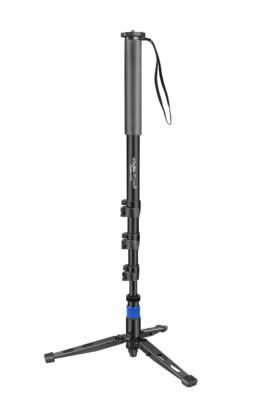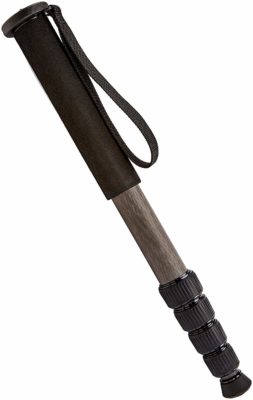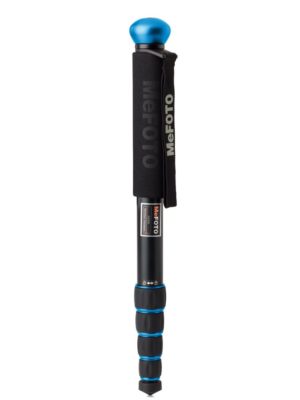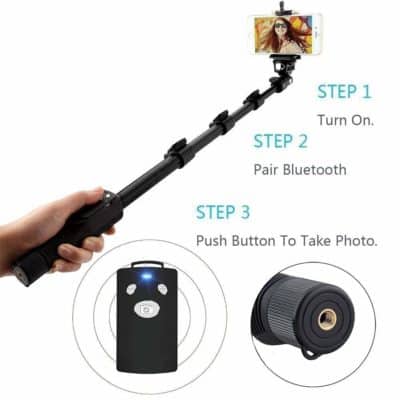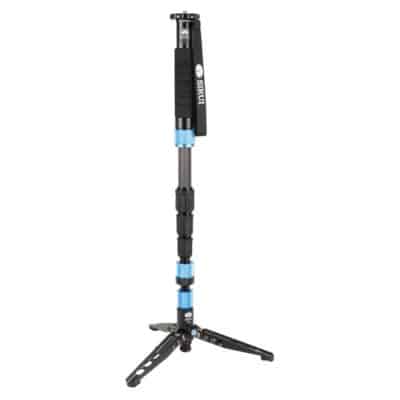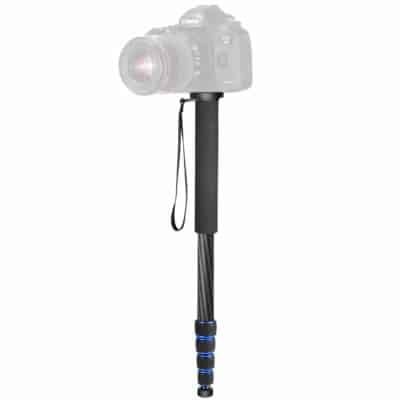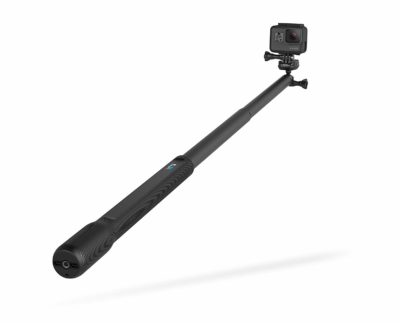Best Monopod
A monopod can also be described as a Unipod, and it is a single staff or pole that cameras are placed on for support. It can also be used for binoculars, rifles and other precision instruments in the field. However, this instrument is mainly used for the camera.
It is used to make a still camera more steady, thereby allowing the photographer take sharper pictures at slower shutter speed, coupled with a longer focal length lenses. In videography, it is also used to get a steadier capture of the motions of characters. This is because the camera is prone to less shaking in this condition.
In the photography and videography world, stability is as important as it can get. Though there are many instruments that can make do with the monopod, the most important is photography and videography. A monopod and a good voice recorder is key to a good video. So now when you have decided to buy one, you require complete guidance to choose the best one for use. This is the reason why we have included how to use a monopod, features of a good monopod, advantages, buying guide, frequently asked questions and the top 9 best picks of professional monopod in the market.
Top 9 Best Monopods
| Product | Best Price |
|---|---|
Our Pick | |
Our Pick | |
Ideal Hiking Monopod | |
Portable and Stylish | |
Optimum Stability and Flexibility | |
Quick Power Lock System | |
Very Lightweight | |
Best for Video | |
Waterproof and Durable |
How to Use a Monopod?
Using a tripod might seem as tough but it was the best when it comes to photography and other instruments. However, the use of a monopod might really be handy and best in some situations. Using a monopod might be a big help in serving as support for your larger cameras/lens combination. Using a monopod might be sometimes tricky, and if you want to make use of it effectively, there are three main methods you can follow. These methods, however, only differ in the way the foot of the monopod is placed.
Straight out in front
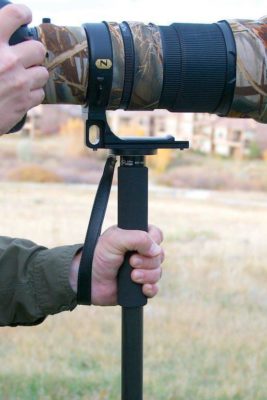
This is the logical way to use a monopod, hence, most people when they first start out with photography would use it this way. Users would stand behind the monopod, with the legs standing square approximately to the shoulder width. The foot of the monopod would be held out between their own legs, and straight out in front of them. In this position, the foot of the monopod would then form sort of a triangle with the feet of the user.
In this position, the stance mimics what a tripod would actually do, resulting in the balance needed to get the best shot possible. To improve on stability, the wrist strap should probably be used, to firmly push the monopod foot into the ground.
Doing this, you would notice that the monopod would be firmer, as the strap is not just for carrying the monopod. It serves to make sure that the monopod is prevented from rotating. You should ensure that the length of the wrist strap is minimal, and not too long. You should also confirm the position it places your hand before you purchase the monopod.
If you are going to be using a large telephoto lens, and you should use this more frequently. However, the other two methods are not without their advantages. Since the other methods would be used at an angle, you have to ensure that your monopod has a rotating head.
Bracing the monopod feet against the instep of your rear foot

This method is pretty simple, all you need do is to stand with your hips at an angle degree to your shoulder, just as a boxer would stand. One foot is shifted backwards a tad, with the feet of the monopod braced against the instep of this rear feet.
The pole of the monopod is then at an angle to the other leg for extra bracing. You should ensure that your hand is in the strap, pushing the monopod into the ground, just as described in the first method.
Placing between the legs
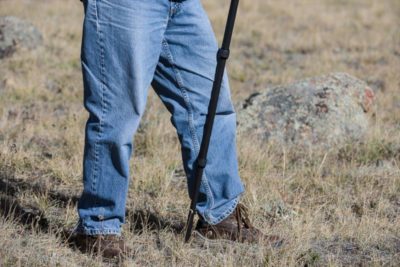
This is also similar to the second method, however, there is a little difference. In this case, the leg of the monopod is not close to the hind leg, but close to the leading leg, just behind it. In this method, the leg of the monopod is braced against the leading leg, hence, resulting in more stability. Just like the other two methods, the monopod is pushed into the ground.
Using the monopod with a head
There are different kinds of photographer. Sports and wildlife photographers might not really be inclined to using the monopod with a head, but you can always use it. The head and screws however, must be able to support the weight of the camera and the lens. There are different types of head, which could range from a simple tilt, to ball or a gimbal head. You can take up any of these head types for use, but many believe that the simple tilt is all that you would ever need.
As a photographer, if you are going to be using a head for your monopod, there are different heads adapted for different situations. The ball head works just fine for landscape shots with wide angle lens. The gimbal head works well for larger telephoto lenses.
Before you go all out to get your monopod, you might need to decide what type of head you would be getting with it.
In taking pictures with the monopod, you might need to try the different methods of using the monopod. This would help you know that one that works better for a clearer and sharper shot. Try to figure out the one that fits well with your needs and style.
Features of a Monopod
There are a few parts of the monopod that you should be conversant with, and they include;
The feet: This is one feature of the monopod, and in this case, the instrument has just a foot. This is unlike the tripod, which has a combination of three for more stability and standing on its own.
Swivel heads: This is the part of the monopod that allows you to change the angle of your camera, such that you can tilt it forward or backwards. This part of the camera is sturdy and affords the photographer a great structural stability for sharper photos. So, if you would need to shoot with your camera facing upwards of downwards, this part of the monopod makes it easier.
Quick release mount: In cases where the camera would need to be replaced swiftly and fast during a shoot, the quick release mount might come in handy. It saves time of having to thread the mounting screws into the bottom of the camera.
Shoulder strap: This is the part that allows to simply have the monopod hanging on your shoulder, without getting to have another piece of equipment on your hands.
Hand strap: The hand strap allows you to hold the monopod in your hand. During shoots it can also be used to hold down the monopod to a point.
Carbon fiber: There are some monopods that are made of carbon fiber. This is in a bid to make the monopod of a lighter weight.
Pistol-grip ball head: This is a type of head that is also found on a monopod. They are easy to use and can be adjusted to any angle. They are stable and it is a good idea to invest in them.
Ball head: Some monopods also make use of this type of head, which is the most common type that comes with the monopod. It is a regular and quick release head, making the monopod as flexible as it can get.
The leg: Traditionally, a monopod is supposed to feature just one leg, which is seen in most monopods. However, in recent products, we see additional of some few legs, which are in a bid to enhance stability when in use. More often than not, the legs are always a group of three.
Advantages of a monopod
Monopods are not new to photography, and while in use, there is so much advantage it can offer the user.
Monopods can be attached to the camera pretty easily, and can also be packed in the bag easily.
With the use of monopods, you can make even better videos
When you go backpacking, you can also use the monopod as a lightweight walking stick.
Action photography fairs well with the use of a monopod, as they can be rotated easily on the spot.
Monopods help you avoid common mistakes when going through with photography in a telephoto setting
Monopods can serve as an image stabilization system, and it does it quite better. It allows for the use of a slower shutter speed which would result in a sharper image.
Monopods are always on the go, irrespective of how small the area might be. A tripod might not function in this case.
As a photographer, using a monopod affords you the professional appearance.
Buying Guide for the Monopod
It’s no news that monopods differ from tripods, in that it has just one leg, while the tripod has three. However, this does not make it less valuable in photography. As a professional photographer, it is safe to have both, as they are adapted to different purposes.
It is not impossible that all you have as a photographer is the tripod, now you should get the monopod. In getting the monopod, there are a number of factors that you should duly consider while buying professional monopod for dslr, because, getting a monopod is just as crucial as getting a tripod.
Load capacity
The load capacity of your monopod is the weight it can sustain before losing stability. When a monopod is overloaded, the camera shakes due to vibrations. Different monopods have varied load capacity depending on their use. Make sure the load capacity of your monopod is at least two and a half times of the device you use for clicking photos or shooting.
Material
Aluminum and carbon fiber (CF) are the materials available for monopods. Aluminum monopods are less costly as compared to CF monopods. However, CF material monopods provide more stability while clicking pictures that would otherwise give you a shaky effect in aluminum monopods. If you are a beginner and do not want to spend much, choose an aluminum monopod.
Function
The very first thing is to consider what you need it for, if it would be of any use to you as a photographer. Travel video monopod is of common use to photographers that engage extensively in outdoor photography. So, if you are not one to walk up mountains, or down the valley just to get the perfect view and perspective, you might not need to get a monopod. Outdoor photographers use this instrument more, as a result of its light weight and the easy with which it can be set up.
Durability
You don’t want a monopod that would get spoilt in less than a year of use, as a result of experiencing various weather and conditions. You have to check for the materials from which it is made, as that is what determines its durability.
Different materials are used to make monopods for various reasons. Monopods can be made of aluminum, basalt fiber, or carbon fiber. Of these, the best material would be the carbon fiber, as it is a combination of lightness and portability and durability. Whatever the condition or weather, you would have no problem with the carbon fiber monopod.
Portability
As an outdoor photographer that is to capture far and near, traveling is not really an option. Moving from one location to the other can be very tedious with the tripod, but with the monopod, you are always on the go. Owing to the fact that there are different materials used in making monopods, there is also a variation in the portability. Hence, you should choose the monopod with the greatest portability.
Height
it is important to know how high the monopod you are getting can get. Though this is based on preference, it is advised that the monopod is able to get the camera as high up as your eye level.
People have different height preference, so you need to decide which would best serve your aim and most especially your style. Working strictly in your style might deliver a very fun-filled experience.
Weight capacity
The size and weight of the camera you would be using on the monopod is really to be considered before getting one. The monopod must be able to complement the weight of the camera and the various lenses you might want to use. When you get some monopods, the manufacturers are likely to include information on the weight on the package.
Also, you are surely aware that the heavier your monopod, the sturdier it would be. But you might be disgusted by the weight when you are traveling or moving around. Heavier monopods tend to support heavier cameras. Hence, you need to weigh your pros and cons, to know what you should go for.
Stability
Your monopod must be stable, and not just shaky if you want to take very good pictures. If the monopod is not stable, the photography session might end up in a mess. Carefully test out, to see how stable the monopod is before you drop your hard earned cash. You should check if it resists ground vibrations if it is resistant to strong winds, etc. Try all occasions and see how the monopod fairs, before you purchase it.
1. Digitek Ultra-Portable Platinum Monopod
The ultra-portable lightweight monopod by Digitek is made up of strong aluminum for heavy-duty that has a load capacity of up to 10 kg. The monopod can be easily and safely transported since it can be converted into a compatible size, which easily fits in the zippered bag provided.
Whether you are a professional photographer or novice, the monopod is a feasible choice. You can capture vivid, professional-style photographs with this monopod.
The monopod supports a wide range of video cameras, digital cameras, still cameras, GoPro devices, and smartphones as it has a universal standard adapter and has user-friendly features. The monopod provides more stability with built-in cushion grip and adjustable wrist strap with three foldable self-standing legs. This ultra-compact monopod includes stabilization for your camera or camcorder.
Main Features
- This monopod weighs only 1.3 kg and measures 26.6 to 67 inches long (fully extended) and can be molded as per convenience.
- The height can be adjusted using the rubber twist locks up to four sections.
- The minimum height is 2.21 feet, and the maximum height is 5.57 feet for optimal performance.
- The product dimensions are 68 x 20 x 20 cm and come with a zippered bag for easy transportation.
- The three leg base and 30 mm rubber tube with ball head helps easy mobility of the monopod.
- It prevents your hand from slipping while clicking pictures as it has a non-slip foam grip.
- The monopod is sturdy and durable and easy to use at a cost-effective price.
- It has excellent build quality and finishing.
- Excellent load capacity up to 10 kg and smooth pan head.
- The leg support is not reliable.
- The bag does not have straps.
2. AmazonBasics Carbon Fiber Monopod – Our Pick
With the AmazonBasics carbon fiber Monopod, you can always hold a camera securely in one place. With this monopod, you can always use the SLR, compact and action cameras, and it can support camera weight up to 22 pounds. This is therefore the best monopod for action camera.
If you are a photographer who is always on the go, this is your catch. This monopod is made of 8x carbon fiber and provides you with supreme strength. However, the strength provided by this monopod, it is very light weight, unlike the monopods that are made of aluminum. The monopod features a convenient screw-in metal spike which is relatively easy to install, and can provide a great deal of stability in dirt, grass, gravel and other uneven terrains.
The height of the monopod can be adjusted with the five telescoping sections and easy grip rubber twist it features. All you need do, is simply twisting the rubber locks to extend or collapse, then you can tighten it into place.
When the monopod is fully extended, it can measure up to 61 inches in height. It folds down to 17.5 inches. It is easy to carry around and can be stored away quite easily.
If not anything, the AmazonBasics monopod is very user friendly, with wrist straps for carrying and a comfortable grip for the user’s hands.
- It is made of lightweight 8x carbon fiber
- It only weight about 0.43kg, and a collapse length of 17.5 inches, while it is 61 inches on extension
- It is built to support weight up 9.97kg
- It features 5 expandable sections with rubber twist lock.
- It comes with a 1 year limited warranty
- It is very lightweight and compact
- It is value for the price
- The parts are not well screwed, you might need to re-screw before use
- Tightening rings give trouble working with it after a few months of use
3. MeFOTO WallkAbout Convertible Walking Stick/Monopod – Ideal Hiking Monopod
Made of aluminum, this monopod that is easily convertible to use as a walking stick rises to a height of about 59.1”, and fold down to 18.1”. it weighs a total of 1.4 pounds. It is a 5 section aluminum alloy monopod.
The WalkAbout is designed to feature a comfortable blue knob that has an inlaid compass for easy reference when hiking. You can easily adjust the height with the twist locks with blue accent rings that echo the knob.
It also has an optional leg feature that is studded with rubber grip. It can bear on camera or instruments that weigh up to 30 pounds. Either you use as a walking stick or as a monopod, you are assured of stability and steady support and hence can also be called as the best monopod and walking stick.
- It can support a load of 14 kg in weight
- Its length can be extended to about 59.1” in length
- It has a rubberized grip
- It is designed to fit as both a monopod and as a walking stick
- It is easy to use as a monopod and a walking stick
- It feels more solid and compact.
- You can always go hiking with this stand
- It is very versatile to use and flexible
- It has to be held continually by the user to avoid falling over
4. US1984 1288 Bluetooth Selfie Stick for Smartphones and Monopod – Portable and Stylish
This monopod features an adjustable head and thumb screw locks that allows for multiple angle shooting, round 360 degrees. The handle is simply made of rubber and has a strap attached to it for safety. It is made of reinforced aluminum tube that allows you to reach a length of 48.4” while maintaining stability during shoot. It features a remote shutter that can be detached for separate use whenever you want to.
On the monopod, there is a lock which can be adjusted to any length you want between 425mm to 1250mm. The shutter can connect to iOS and Android devices. However, the zoom buttons only work with Samsung smartphones, which is due to camera restrictions in most mobiles.
With this, you can take better photos. The monopod is compact, foldable, durable, lightweight and extremely portable. With this, you can take steadier and sharper pictures. With this monopod, you can always record happy moments, times you spent with family, travels, etc.
- It is made to be foldable
- It features an adjustable head and thumb screw
- It is made of reinforced aluminum
- It fields Bluetooth device connectivity.
- It is very compact and foldable
- When used with Samsung phones, it can be very smart with its working
- It has a really nice grip
- The zoom feature can only work with Samsung smartphones, and this is a big restriction for other users.
- Bit heavier than others
5. Sirui P-204SR Aluminum Photo/Video Monopod – Optimum Stability and Flexibility
First, this monopod is made of carbon fiber, and it gives it a super-light feel, with the durability you wouldn’t be able to imagine. This monopod features optional three sturdy support feet or you can say it as a three leg monopod that is meant to give it extra stability and flexibility.
However, these feet can be removed for use as a standard monopod. It features a patented panning grip that can rotate smoothly over 360. There is also an adjustable friction control on the baseball head which allows you to adjust the tension for different weight equipment and resistance equipment.
The weight of this monopod is lighter than you can imagine, as it features eight layers of 100% carbon fiber. This affords it extra strength, an increase in the load capacity and a reduction in vibration. It also features a patented base locking collar that keeps the monopod rigid.
Remember that there are three optional feet that can be detached from the monopod, you can always use these feet as a table top tripod. The rubber foot can be used on whatever texture of ground, which could be wooden, stony or sandy. This is just the perfect monopod for you. If you are going to be involved in a lot of travel, you have nothing to worry about, this monopod comes with a warranty of about six years.
- It features a 360® rotation for panning and panoramas.
- It features a twist lock that allows for maximum security and gives comfort when handled.
- It comes with an optional three feet for stability.
- It comes with a foam grip to ensure a solid hold.
- It can support weight up to about 8kg
- It has a maximum height of 1600mm/63 inch
- It is very sturdy
- The legs are just perfect, if you have room for it
- It can function quite well in spontaneous situations
- It has a very high quality
- Without the legs, you cannot leave your camera standing on it
6. Manfrotto XPRO 5-Section Photo Monopod, Aluminum with Quick power lock – Quick Power Lock System
You can’t just get enough of the high functionality of this monopod. This monopod is a brand new professional camera monopod that has been made to satisfy photographers, who are in dire need of a highly portable, high-performance solution they can easily carry with them when traveling.
The MPMXPROA5 is the most compact Manfrotto monopod you would ever find these days. When you are going traveling, you can easily toggle it into your backpack or messenger camera bag. However, manufacturers cannot make a monopod more compact, at the expense of it functionality, hence, this monopod still has the capabilities of the Manfrotto 190 collection. It also features a 055 collection leg, making it more rigid as well as providing it with locking safety on a professional level.
If you are opportune to combine this monopod with the 234RC monopod head and a good camera, you are sure to enjoy enhanced shooting experience, as it would dramatically increase framing speed and versatility.
In no time, you can convert this photo monopod to a nice video monopod and get things going. This monopod features an innovative FLUIDTECH solution which allows for a fluid #D movement, with a pioneering technology based on a spherical system located inside the base which delivers ultimate smoothness through an expanded range of perspectives.
This monopod also features three feet that can be retracted, thereby making it as portable as it can get, when folded. You can carry this monopod with you, just about anywhere you would love to go for a nice photography adventure.
- It is designed specifically for travelers
- It is designed to be portable and can easily fit in a backpack
- It features a new rubber leg warmer design for a fast and secure movement
- It features a quick power lock system for rapid and effortless, reliable set up
- It is very portable and can easily be carried around
- It can support weight up to 6kg
- Easy to set and use, made of durable material
- The price is fair for the quality of material delivered.
- It does not come with a leg stand
7. Neewer Carbon Fiber Monopod for canon Nikon Pentax Sony Olympus DSLR – Very Lightweight
Don’t get deceived by the image above, when you purchase this product, camera is not included in the package. This monopod is compatible with various brands of cameras, such as; Canon, Nikon, Pentax, Sony, Fuji, Lumix, Olympus DSLR and video camcorder.
This monopod is made of carbon fiber, thereby making as lightweight as possible. It is durable and has been carefully designed to aid in the stabilization of equipment, when used in different locations. It can also be converted as alpenstock if there is a need for it.
It features a 5 leg section that is fitted with twist locks anti-rotation system, which offers an adjustable height from 18.9 inches to 64.2 inches.
It features a non-slip foam rounded hand-grip and wrist strap which ensures a safe hold and avoid the risk of the camera dropping.
Apart from the non-slip rubber for flat ground, there is also the presence of a screw-in metal spike, which allows for easy installation and enhances stability on dirt, grass, and other uneven terrains.
- It is made to be of a wide compatibility, which fits a wide range of cameras
- It is made of light weight 8X carbon fiber
- It is made to have an extendable height
- It is carefully designed to have an ergonomic design
- They are handy for travel to any terrain.
- It is very light weight and can be carried around easily
- It is not as bulky as the counterpart tripod
- It is made to be very sturdy
- The parts might not be screwed in perfectly, you need to check while purchasing.
8. Sonia Monopod MPL 09 with carry case load capacity 8kg – Best for Video
This is the perfect monopod if you are looking for something great and without spending much. Easy to carry as much as it can get. This monopod weighs a total of 1.4kg, and it can reach up to maximum height of 175cm. when folded, it can go as low as 60m. This economic monopod can support load up to about 8kg in weight. Featured on this monopod are self-standing legs, and a fluid video pan head.
- It features a fluid video pan head
- It is equipped with a quick release plate and bubble level
- It comes with a carry case
- A mobile holder can always be attached to this monopod
- The monopod is strong and steady
- Many users have appreciated its quality
The head can be replaced.
9. GoPro AGXTS-001 El Grande Extension Pole – Waterproof and Durable
Are you out looking for something simple to get your camera set for your photo session? Then this is the right equipment for you. Coming at a very cheap price, the GoPro AGXTS-001 El Grande Extension pole (Black) is all the flexibility you would ever need.
It features a premium oversized grip that allows you to comfortably hold the El Grande with two hands. It is durable and waterproof. The El Grande pole can extend up to 97cm, and collapse to 38cm, and it is always on the go when you want to use it.
- It is waterproof
- Features a twist lock design
- It has twist and lock design for easy use
- It is of a high quality
- It is very durable, as it can be used in any weather and at any speed
- The grip of the monopod is excellent
- Ideal for taking low level moving videos
- It has a very short extension.
Frequently Asked Questions
1. Is a monopod better than a tripod?
Though the purpose of tripods and monopods is similar, they have vast differences. A tripod is more stable while a monopod is mobile. You can use tripods for long exposure photography like clicking landscape photos.
Monopods are a excellent choice for stabilizing long lenses for capturing moving pictures like sports or wildlife photography. In case you want both stability and mobility, you can buy a tripod that can be converted to monopod.
2. Why do I need a monopod?
Monopods are the best choice for capturing fast-moving images since they are mobile. So if you are a wildlife or sports photographer, monopods are ideal as you will be able to quickly react to any action like a running animal or a football goal. Monopods are quicker to reset. Hence you can carry your camera without having to readjust. Monopods can hold heavy lenses for an extended period.
3. Do I still need to get a professional monopod if I have a tripod?
Yes, you might need to get a monopod if you are into outdoor photography. Monopods and tripods have different areas where they have the most influence. Monopods are great to use when you are not having enough space. And when on outdoor photography, monopods are easy to move around and rotate, especially in cases of motion photography.
4. How do I keep the use of the monopod smooth?
When using a monopod, it is advised that you hold it close to your body. It is preferred that the monopod, camera and your elbows are drawn close to your body, as much as possible, this is in a bid to avoid shaking as much as possible.
5. How do I get to clean my monopod?
You should be advised that cleaning with chemical products might simply be dangerous to the body of the monopod. It is better you frequently clean with a wet cloth. All you need is a clean damp cloth or paper towel.
5. Can I use my monopod in the studio?
Monopods are well adapted for use in outdoor photography, they might not really be the best in studios. In the studio, there would be a need to leave your camera standing while you coordinate or attend to some other issue. Only a tripod can serve in this case, while a monopod cannot. Even if the monopod has attachable legs, it would not be as firm as the tripod would be. It is safer to use a tripod.
6. How do I use a monopod in cinematography?
Stabilization is key when it comes to cinematography, and with a tripod, you can be sure of this. However, in cinematography, monopods have a whole lot to offer. It is not going to do everything you want it to do, but it surely has its own usage. It has unique characteristics that makes it the best equipment for some specific type of shots.
Hence, there are a number of ways in which you can use your monopod for cinematography, which include;
- You can mount gears that are not cameras on it. Lights, external recorders, and lots more. Monopods are versatile in usage.
- You can always use the monopod to get some really cool POV shots, and you don’t have to worry about carrying extra luggage as it can be collapsed safely into your backpack.
- No matter where you are, you can always turn it upside down, if you are looking to get a low angle tracking shot.
- With a monopod, you can always create a natural-looking camera shake, which cannot be created smoothly by the tripod.
- Also, if you are going to locations or places with no much space, a monopod can really be handy.
These are just a few of the various ways in which you can use the monopod in cinematography.
7. I don’t have much money, which should I get, monopod or tripod?
Well, both are really pertinent for you as a photographer or cinematography. They both have areas in which they are unique and unbeaten. A monopod would never be like the tripod when it comes to stability, even though it is relatively stable too. A tripod would never beat a monopod to flexibility.
However, if you are looking to cut cost, and just want to get one of the two. Since, you would eventually need to get the two, it is advised that you examine your current condition and projects you would be embarking on in near future, this would help you determine the equipment that is perfect. If it’s going to be outdoor photography, a monopod is better. If it’s going to need a great deal of stability, just go for the tripod.
Conclusion
Monopods are the best when you are outdoor, taking landscape photos or wildlife. They offer you a great deal of ease, as you would be able to adjust, change directions and capture motion images. It is more swift to do this than using a tripod. For every photographer, tripods are great, but you can’t take away the place of the monopod.
Hopefully the above 8 picks will become a guidance for you to choose and also we feel that AmazonBasics Carbon Fiber Monopod, MeFOTO WallkAbout Convertible Walking Stick/Monopod and US1984 1288 Bluetooth Selfie Stick for Smartphones and Monopod are the top 3 best professional monopod for dslr that you can rely on.
There would be times you want to travel heavy or have a lot of stuff making you feel clumsy and all, in this case, you can still ensure stability and support with a monopod.





